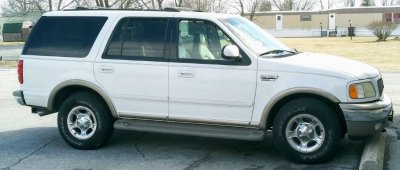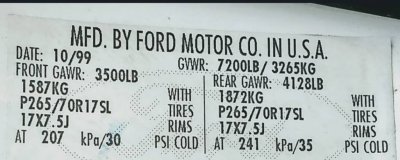Toby, your not old enough to remember the Ford's with Firestone 500's back in the 70's. A lot of lawsuits, and people got hurt. Ford as usual with held info from Firestone. That and just a cruddy design from Firestone itself, where the tires started separating at higher speeds. 390 Cid Ford's were capable of 120 mph. Sadly the tires weren't. Biggest tire recall in history, over 7 million Firestone 500's had to be replaced. I've never had a set of Firestone tires on any of my cars/trucks. A lot of Michelin, some Bridgestone, same company. I'm betting Ford and Firestone knew, but like the Pinto, said to the other suits, let's see how bad it gets, better notify legal, this might be a problem a few months from now!
Sent from my N9131 using Tapatalk
You are correct. I was not aware of that major recall or Firestone 500. It just amazes me though that just today people are not aware of the Firestone Explorer tire Fiasco. The problem was Ford was telling people to put 28 and 32 lb in Tires. Tires naturally lose some are especially when it gets cold so they were running around with 18 to 20 lb of air in their tires and they suffered rollovers and blowouts. I never ever concern myself about the manufacturer says about Tire loading pressures. I would much rather trust that manufacture of the tire with what they stand on the sidewalk. There could also be issues with them overestimating for not knowing about some structural defects but that is the literal horse's mouth to get it from.
I know you would think a major manufacturer like Ford or any car company would be smart enough to research and to know but I still trust the tire manufacturer better. Here's a fun story for you....
I've owned and been around a lot of limos over the years and limos back in the late eighties we're just 54 - 60 in stretches and not much heavier than a normal car. From the early nineties on they started getting bigger and bigger until the industry standard car was a 10-foot stretch in the middle. You could put 8 to 10 people in here plus you had the full trunk of luggage and often luggage up front with the driver. Many coach Builders remove the front seat and leave it open or put a chauffeur's caddy storage / writing tray up there.
Even cheap tires pretty much have the same load capacity for their rated load as expensive tires not that I would trust them to perform as well but they are supposed to. I have seen 10 foot stretch limos and even a 165 inch that held 12 to 14 people with the Pep Boys 4 for 160 or 4 for 180 cheap Brand Tires on there. None of them ever had tread separation or blowouts. I have done the math and while most Passenger cars are way under any chance I'm approaching the limit of the tires, these situations we're not.
Now the fun part. I have also seen huge SUVs I hold 20 people and some up to 24. All of these have load range e tires but some of them make you wonder how the tires hold up so well. We're talking about a vehicle that is just under ten thousand pounds empty.
Now when manufacturers and DOT estimate the weight of an average person they tend to go a little low like 150 or less.
People often weigh more than this but when you're not talking vehicles with individual seats it works out to be the same because if everyone weighs 250 pounds you're not going to be able to get 20 people in a 20 passenger vehicle. You'll be at 16-17 Max because they just physically won't fit because they're too wide and taking up room on the seat.
Here's some weird things that I have with us personally. One vehicle that from the manufacturer said and its current configuration this vehicle not to exceed 20 passengers and rear. Stated to use 245-80 16 E tires on there with a maximum loaded stamp on the sidewall 3040 lbs. But, the vehicle says that inflation of 110 PSI. Something is not right here folks. Every load range E Tire and this size says maximum inflation of 80 psi. Only Tire load rating trailer tires in an F or G or a 22.5 inch bus Tire says 110.
When you start adding up the weight you are dangerously close or over the limit to what the tires say they can hold. However another manufacturer of a similar 20-22 passenger stretch SUV sold it with 245 70 16E tires and those have a rating of 3444 lbs. 400 lb extra capacity for a tire is a big deal. I don't know if this is the heaviest load Rated Tire thats commonly available either that's just two that I have witnessed from two different coachbuilders and wonder why they would do such a large difference in load capacity. I have seen buses on e350-550 chassis the same way. They use 225 75 16 R with dually on rear.
Luckily, tires are quite overbuilt and very forgiving in most instances.
It just makes me wonder though how a vehicle modifier could bother to write the number of people and the size of tires and the load range but then get the PSI wrong. I don't think it's even safe to put 110 PSI and 80 psi Rated Tire. Anything over five to six PSI above the maximum rate I would consider dangerous. I don't know, maybe their definition of Max is different than my definition of Max



